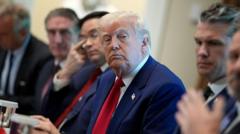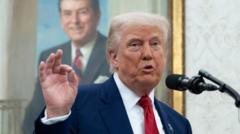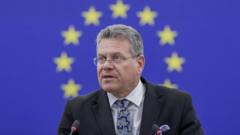President Trump's planned tariffs on the European Union and other trading partners faced a setback after a U.S. court ruling, resulting in a mix of relief and uncertainty among global economies regarding future trade negotiations.
Uncertainty Looms as U.S. Tariffs on EU and Other Partners Halted by Court Ruling

Uncertainty Looms as U.S. Tariffs on EU and Other Partners Halted by Court Ruling
U.S. federal judges suspend President Trump's proposed tariffs, leaving global markets in a state of cautious optimism and speculation over next steps.
The Trump administration's plans to impose substantial tariffs—up to 50 percent on products from the European Union and various other American trading partners—met a significant obstacle after U.S. federal judges intervened and halted the implementation of these across-the-board charges. This legal setback has left many around the world responding with both tension and restrained hope.
On Thursday, following the ruling from the U.S. Court of International Trade, international stock markets reported a rise as investors expressed optimism that this legal intervention could limit escalating trade tensions that have been detrimental to the global economy. Despite this, trade experts and foreign governments responded cautiously, acknowledging that the decision does not eliminate the potential threat posed by the Trump administration.
Economists have warned that President Trump may pursue other avenues to implement these tariffs, casting a long shadow over the brief sense of relief experienced by nations such as Australia, Britain, Canada, and India. In fact, the administration has already signaled its intentions to appeal the court's ruling, ensuring that the precarious situation surrounding international trade is far from resolved.
While the judges’ decision gave the impression of mitigating immediate trade hostilities—potentially leading to more stable negotiations—the reality remains uncertain. The Trump administration's reliance on unilateral tariffs as leverage in trade discussions meant that future developments could quickly alter the landscape. The ruling thus could trigger a phase of intense activity as the U.S. government seeks ways around the legal hurdles in pursuit of its controversial trade agenda.
The decision has created a fragmented environment, blurring the lines between hope for reprieve and the specter of ongoing economic chaos. As the global community awaits further developments, the situation remains a powerful reminder of the unpredictable nature of international trade under the current U.S. administration.





















